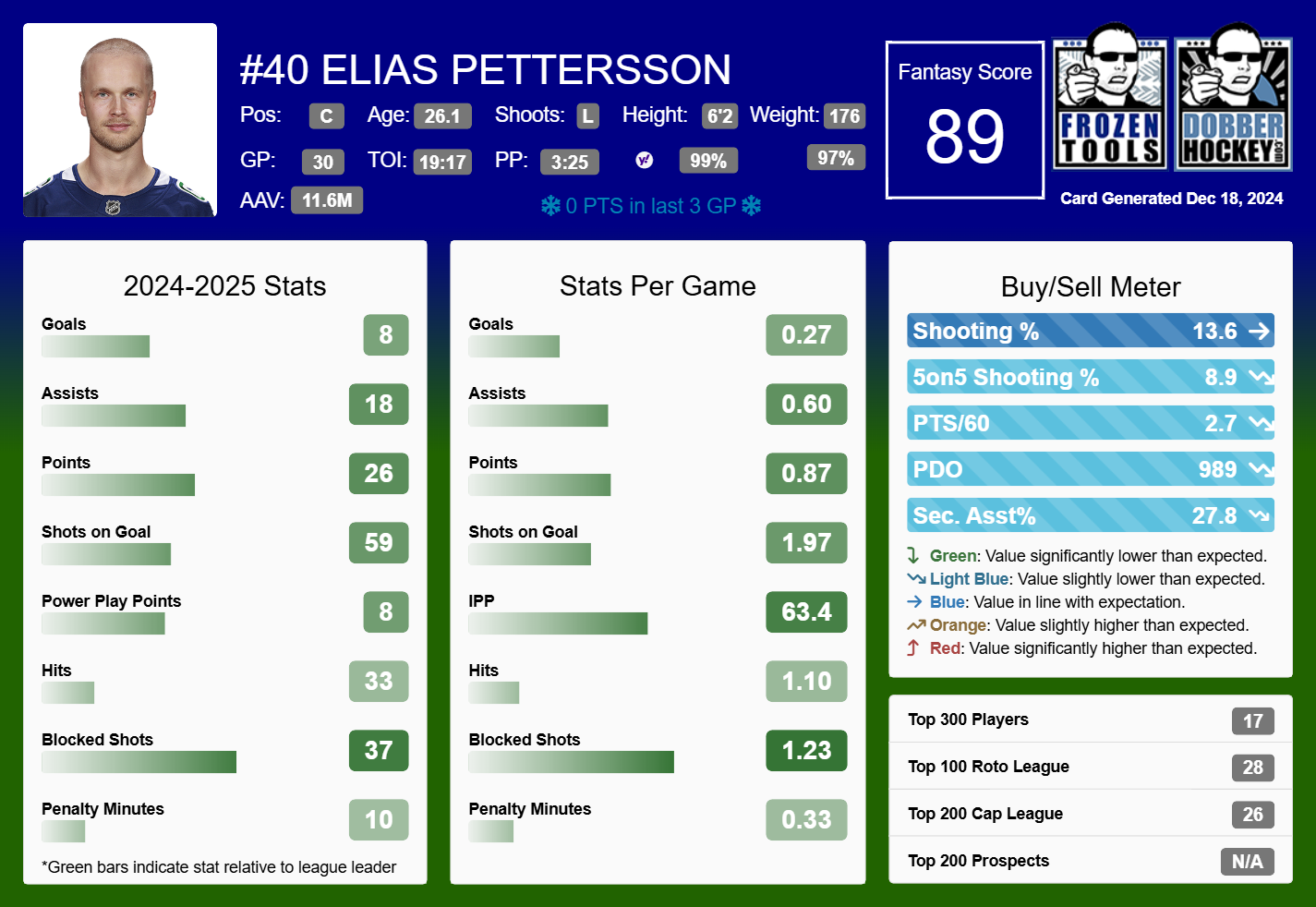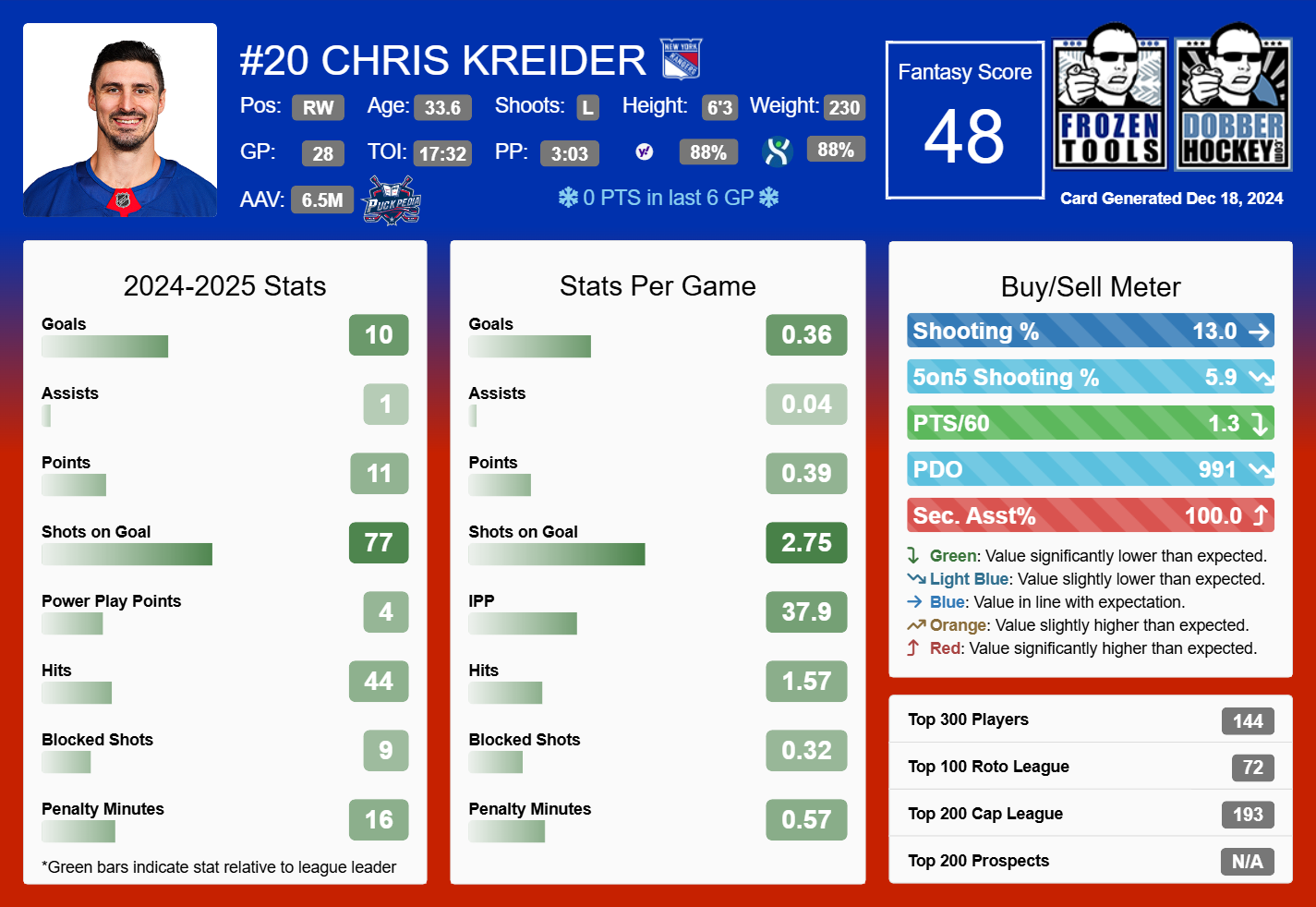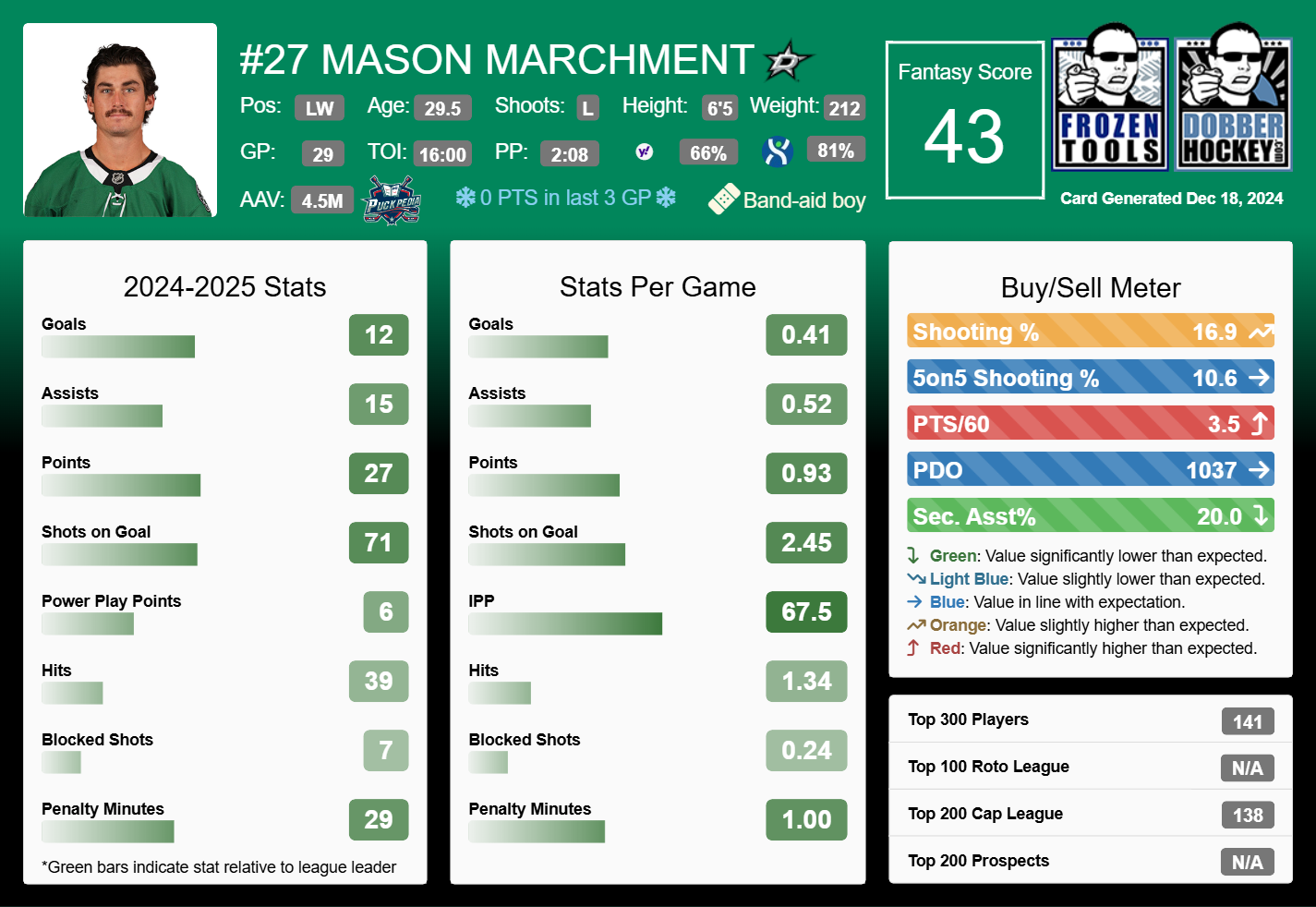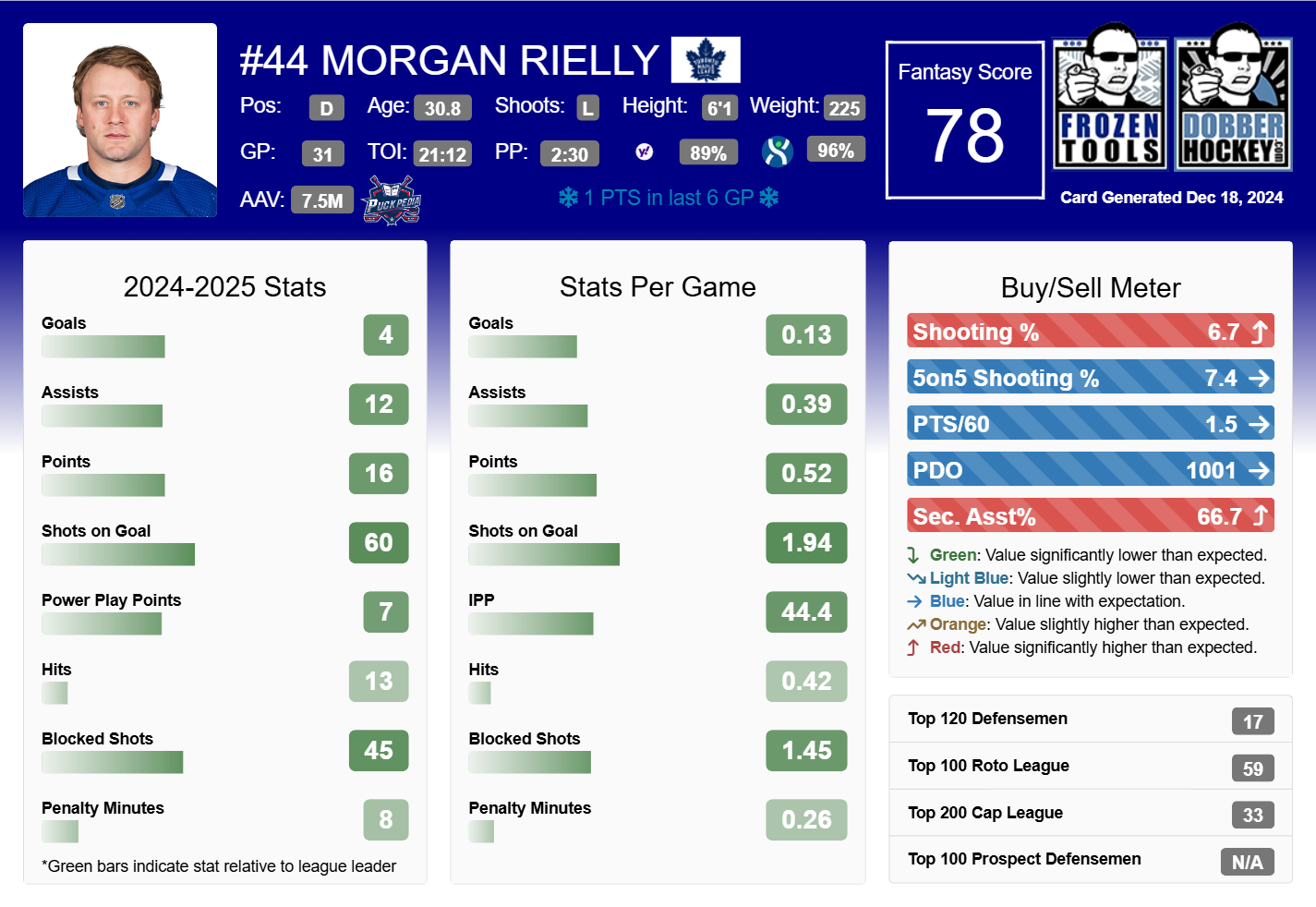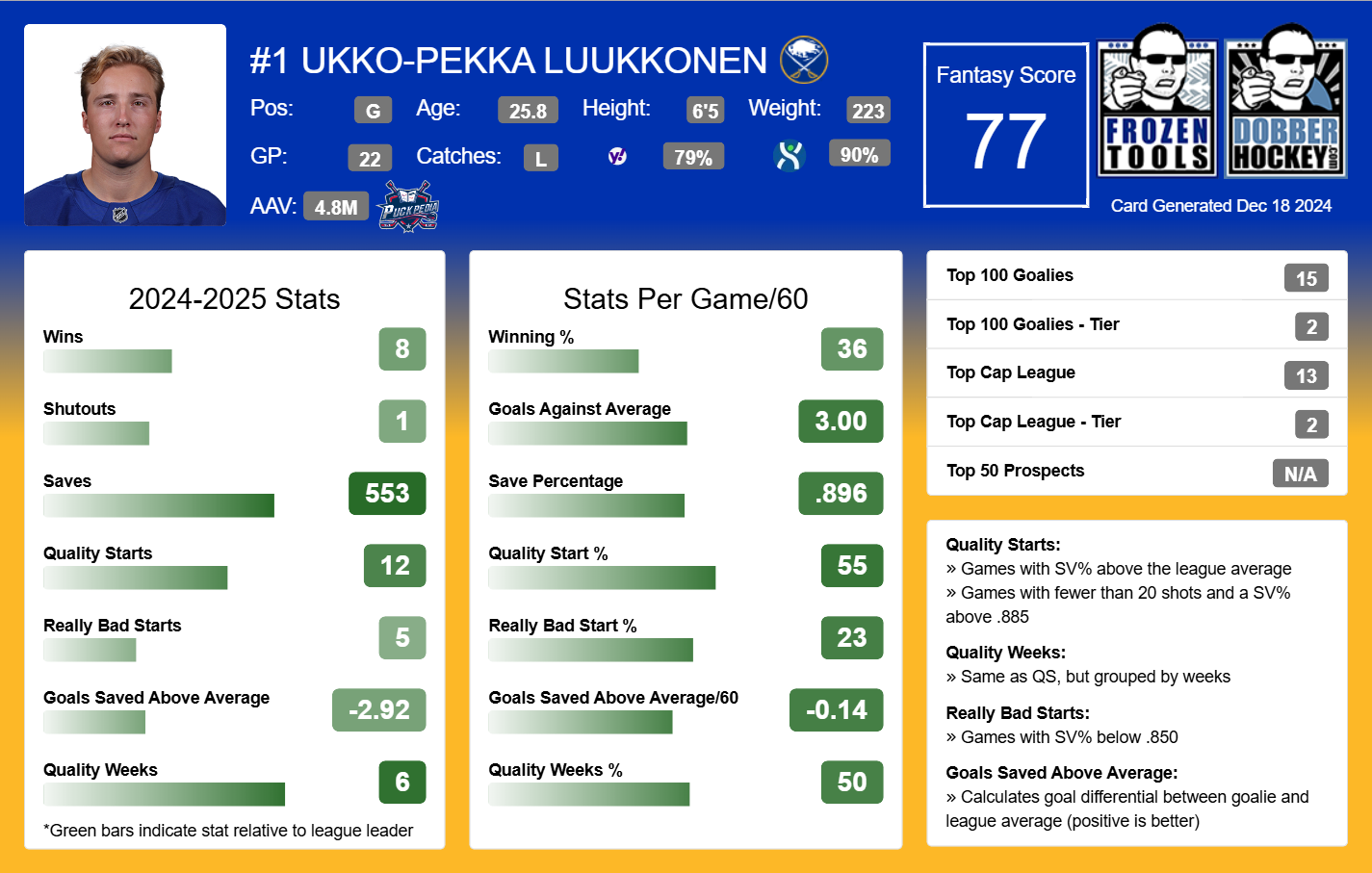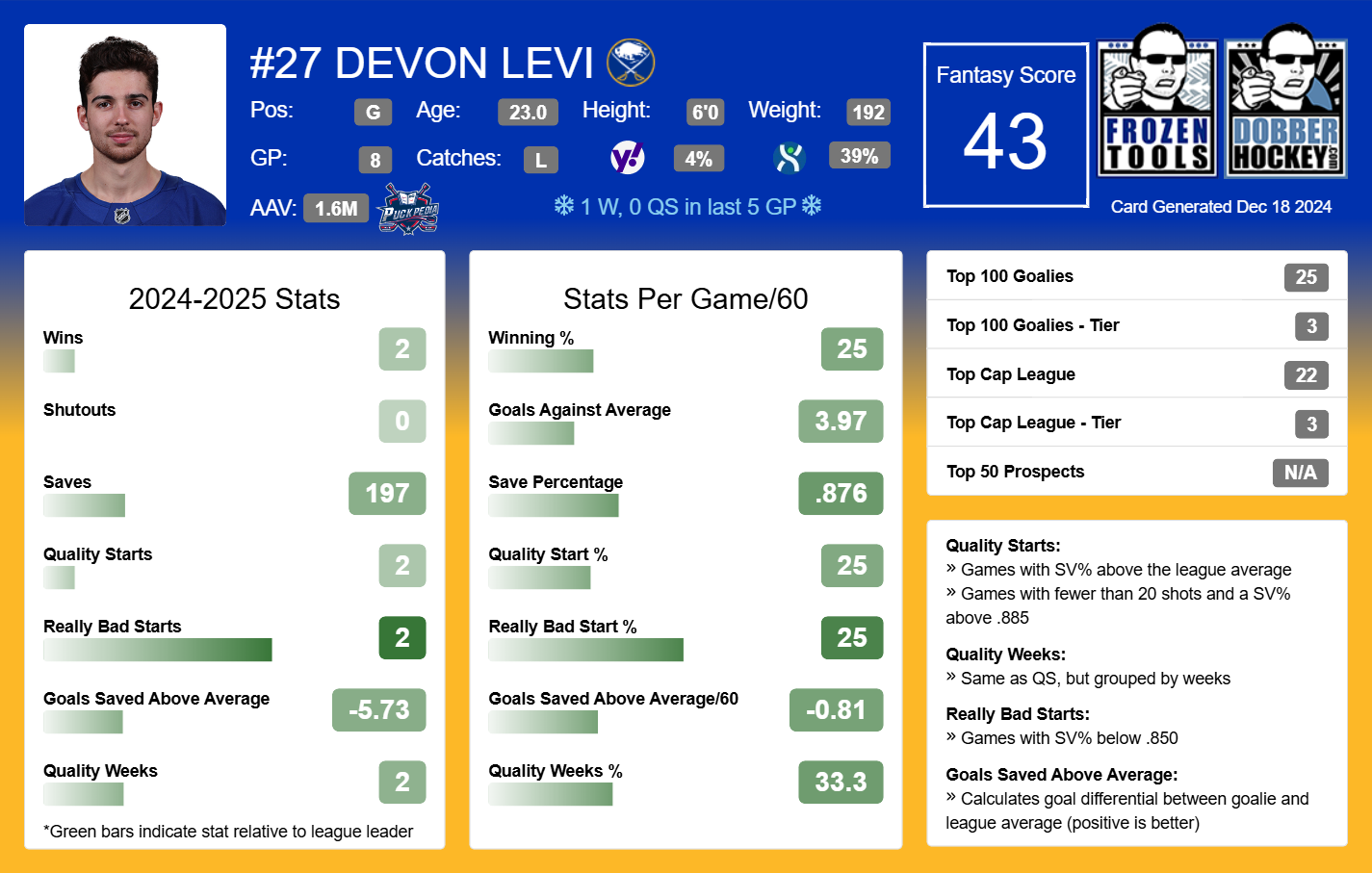"Hold or Fold" for Week 11
Looking at Cold Players in Fantasy Hockey from This Most Recent Stretch
We’re only a few days into week 11 of the fantasy hockey season, but some things are becoming apparent for fantasy hockey managers.
First, I am unsure if any manager should rely on the Rangers or Sabres players.
New York has scored only three goals in its past three games, and it lost yesterday in Nashville 2-0 to a Predators team tied for last in the Central with 24 points. The Sabres have lost 11 in a row and seem to be in a funk, affecting players who are relevant in fantasy. Buffalo has scored only six goals in its past three games while allowing 13 in its last three, including six the previous night in Montreal.
Second, some players returning from injury have boosted their respective teams and shuffled the lines or goalie rotations. Patrick Laine in Montreal, Mats Zuccarello in Minnesota, and Thatcher Demko in Vancouver are players whose recent returns have impacted their respective clubs and caused some roster movement in fantasy play.
With that said, which players in fantasy have NOT had much of an impact as of late, especially over the past two weeks? Let’s examine those particular players in this week 11 edition of “Hold or Fold.”
Elias Pettersson, C, VAN (99% rostered)
Pettersson has had a rough year in general for the Canucks. His PTS/G is down from 1.09 last season to 0.87 this year, and his 82 PTS pace has also declined from 89 last year to 71 this season. Thus, fantasy managers shouldn’t be entirely surprised to see Pettersson being examined as a “hold or fold” candidate.
However, the past two weeks have not been particularly encouraging for the Vancouver center.
Pettersson’s numbers aren’t entirely bad at first glance. He has a goal and five points in his last seven games, averaging 0.71 PTS/G and 2.4 PTS/60.
Conversely, his shooting stats over that timespan are concerning.
His SH% is only 6.7%, nearly half his 13.6% season mark. Additionally, his 5-on-5 SH% is only 8.9%, and his PDO is only 989. He is averaging 2.1 SOG/G in his last seven games, an improvement from his overall mark this season. That said, his SOG/G for the season is only 1.9, a 0.6-shot decline from a season ago.
Thus, Pettersson's shot and scoring opportunities aren’t as plentiful this season. Furthermore, his 18:14 TOI in the last seven games is down from his 19:17 mark for the season. That regression in ice time makes his fantasy outlook even more challenging, especially considering his status as a 99% rostered player in Yahoo.
The Canucks offense has just been inconsistent this season. They have a +3 goal differential, but the fifth-lowest SF/G ( 26.1). His primary linemates, Conor Garland and Jake DeBrusk, have also struggled with Pettersson, as this line has only produced a CF% of 47.4% this season. Based on Dobber line combination data, other similar combinations with Pettersson and those two haven’t resulted in much scoring success.
The issue may not be particularly with Pettersson, but the Vancouver forwards as a collective (or honestly, anyone beyond Quinn Hughes). Still, it seems like Pettersson is not worth carrying for a forward of his draft status (ranked 17th in Dobber’s Top 300 Skaters list).
Thus, fantasy managers may be better off just folding on Pettersson and looking to deal him for another struggling forward whose team has a more positive scoring outlook.
Chris Kreider, RW, NYR (88% rostered)
Kreider seems to be a fantasy casualty of the Rangers’ recent struggles and drama, especially after the Jacob Trouba trade to Anaheim.
In his last six games, the 33-year-old winger has scored zero points, and he only has one point in his previous seven (a mere assist). Over the past two weeks, his SH% is zero, his PTS/G is 0.14, his 5-on-5 SH% is 5.9%, and his IPP is 16.7%.
He still has been generating shots in this most recent stretch, as he has produced 2.6 SOG/G and 8.7 SOG/60, which mirror what he’s been doing for the season. However, the shots are not falling in the net for Kreider (and Rangers in general), and he’s not producing points in any other area this season to make up for that cold goal-scoring stretch (0.04 Assists/G and 0.14 PPP/GP).
Kreider does hold some value in banger leagues. He averages 1.57 Hits per Game, which is not bad for a forward who gets significant minutes in even strength and power play situations (72% PP percentage). Unfortunately, most of his value is propped up by his goal-scoring, and his 0.36 G/GP mark is a 12-point decline from last season.
To make matters worse, his OZ% is 49.7%, down from 57% last year, and his CF% is 46%, a decline from his 51.9% mark a season ago. Thus, it’s hard to see Kreider turning things around significantly in the points department, especially if the Rangers’ recent chemistry issues persist.
Kreider may bounce back metrically when the Rangers make the appropriate roster/coaching changes, which, given the dissatisfaction of the Rangers nation right now, may happen sooner rather than later. That said, I’ll fold on Kreider and look to trade him in most league formats (which I did in my KKUPFL league a week ago).
Mason Marchment, LW, DAL (66% rostered)
Marchment got off to a strong start this year, and his season-long numbers are impressive, especially for a second-line winger.
In 29 games, the 29-year-old Dallas forward has 12 goals and 27 points. He’s averaging 0.41 Goals/G, 0.52 Assists/G, and 0.93 Points/G. He also has a +11 plus/minus and is on pace to score 74 points over 82 games, a 20-point improvement from a season ago.
Unfortunately, Marchment has had a rough recent stretch. He has zero points in his last four games.
In the past week of contests, not only has he failed to accumulate a point, but he also has produced -4 plus/minus, 2 PIM, one block, and zero hits. Thus, besides not being a help in goals and assists, he also has been a drain in other scoreable categories, especially in banger formats.
Even though those metrics are discouraging, managers who roster Marchment should still be hopeful that a turnaround is coming soon, primarily based on the shooting metrics.
Over the past four games, Marchment is producing 2.8 SOG/G, a 5-on-5 SH% of 10.6%, and 10.4 SOG/60. He also has a PDO of 1037, a ZS% of 56.3%, and a Corsi of 55.9%. He is averaging 1:45 PP TOI, which equates to a PP% of 41%. Thus, he’s still getting appropriate scoring opportunities in even-strength and power-play situations, even amidst his struggles over the past week.
So, what’s been the primary issue for Marchment? It could be that he’s struggling to adjust to a line without Tyler Seguin, who had surgery on his lower body/hip a couple of weeks ago and is expected to miss 4-6 months.
The Marchment-Seguin-Matt Duchene line produced 16 goals, a +10 plus/minus, and a CF% of 54.4% in 194:57 TOI. Conversely, the Marchment-Duchene-Logan Stankoven line has only produced two goals, a -2 plus/minus and CF% of 56.4%. Therefore, based on the Corsi data, Marchment’s new line has generated the shot opportunities but hasn’t cashed in as much as his previous line with Seguin.
Fantasy managers who roster Marchment should trust the CF% and that Marchment will figure it out with his new linemates at some point. He is also a first-line power-play forward, so he will also continue to get PPP chances.
Despite this rough recent week of games, he’s a player for fantasy managers to hold for now.
Morgan Rielly, D, TOR (89% rostered)
Rielly is an interesting fantasy player, especially personally, as he was put on waivers in my KKUPFL league a couple of weeks ago. He’s rostered in 89% of the league and around the 93% rostered mark when I picked him up. I acquired him thanks to an aggressive FAAB bid ($50 of my $98 FAAB budget), hoping he would boost my blue-line production.
Unfortunately, after these past two weeks, I can understand why Rielly was let go by his previous fantasy team.
In his past eight games, the 17th-ranked defenseman via Dobber in the preseason scored only three points, all assists. Unsurprisingly, his SH% is zero. He averaged 0.38 PTS/G and 1.1 PTS/60, with a plus/minus of -5 over that sample.
In addition to not producing points, Rielly is not offering much else in other categories. That makes his fantasy outlook concerning for any manager currently rostering him (including myself).
In the last two weeks, he’s only averaged 1.5 SOG/G, 4.4 SOG/60, a 7.4% 5-on-5 SH%, and a Corsi of 49.1%. He’s accumulated only one hit and six blocks in his last eight games, bringing his season average to 0.41 Hits/G and 1.44 Blocks/G. The lack of hits makes him irrelevant in banger leagues.
His primary linemate on the blue line is Oliver Ekman-Larsson, and the pair scored 11 goals in 279:31 TOI. However, they have a plus/minus of -2, and their CF% is only 48%.
Rielly has been much more productive on the blue line with Chris Tanev. In 98:49 TOI, they have only three goals and -2 plus/minus. That said, they have a CF% of 55.3%, showing that they do a much better job producing shot opportunities together than the Ekman-Larsson-Rielly pair.
Rielly remains the Maple Leafs’ power-play quarterback, and he’s been solid in that role, helping the Leafs’s power-play first line net 11 goals, a +8 plus/minus, and 85.2% CF%. That alone makes him a hold.
His long-term viability in fantasy, however, depends on his even-strength production. Hence, his line usage and pairings in even-strength situations in the future could determine how dependable he will be in fantasy.
Ukko-Pekka Luukkonen, G, BUF (79% rostered)
Buffalo sucks. I hate to put it that bluntly, but they’re a brutal team to watch right now, and that was especially true in a blowout loss to the Canadiens, where they were out of it after the opening seconds.
Change will likely soon in Buffalo to shake this Sabres team out of their rut. However, it could be a long haul to the end of the season, disappointing to a fanbase enduring what has felt like an endless rebuild.
Luukkonen has, at times, been a bright spot in this dark Sabres season.
In 22 games, he has produced a 3.00 GAA, 0.896 SV%, a QS% of 55%, and -2.92 GSAA. That doesn’t look positive on the surface, but fantasy managers must understand how the past two weeks have seriously weighed on Luukkonen’s overall numbers.
In his previous six starts, the Finnish goalie is 0-5-1 with a 4.27 GAA, 0.865 SV%, -6.38 GSAA. His QS% is 33.3% over the last two weeks, and while his EV SV% isn’t too bad at 0.885, his SH SV% is a brutal 0.731. There’s no question that the Sabres’ primary goalie hasn’t been good recently, but both the offense and defense have been poor, so it’s hard to nitpick too much with Luukkonen.
That said, the Sabres did recall Devon Levi for a cup-of-coffee start against Toronto on December 15th. He gave up four goals on 40 shots in a 5-3 road loss to the Leafs. The GAA was high at 4.14, but his SV% was 0.900, and his GSAA was only -0.04. Thus, his start was a lot more promising than what the GAA and final score demonstrated.
Here’s what Levi, rated as the 25th-best keeper goalie via Dobber, has done this season via his Dobber player card.
Luukkonen is the better goalie now, but could Levi show some growth and close that gap with another extended chance later in the year, especially if the Sabres can find a suitor for the veteran Reimer? I think it’s possible, and I would keep Levi on one’s Yahoo watchlist, with managers being ready to pull the trigger on picking Levi up should anything happen to the Sabres backup.
Levi being in the AHL right now makes Luukkonen a hold, but he could be a fold later in the year, especially if these past two weeks turn into a longer stretch of futility (like the Sabres themselves).
Photo Credit: Bill Wippert | NHLI via Getty Images




